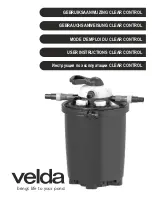
5
Before Starting Installation
WHERE TO INSTALL THE FILTER
=
Place the filter as close as possible to the pressure
tank (well system) or water meter (city water).
=
Place the filter as close as possible to a floor drain,
or other acceptable drain point (laundry tub, sump,
standpipe, etc.). The drain point must be able to
discharge the backwash flow rates shown on page
3.
=
Connect the filter to the main water supply pipe
UPSTREAM OF the water heater. DO NOT RUN
HOT WATER THROUGH THE FILTER. The tem-
perature of water passing through the filter must be
less than 120°F.
=
Keep outside faucets on unfiltered water to con-
serve filtering capacity.
=
Do not install the filter in a place where it could
freeze. Damage caused by freezing is not covered
by the warranty.
=
Put the filter in a place water damage is least likely
to occur if a leak develops. The manufacturer will
not repair or pay for water damage.
=
A 120V, 60 Hz electrical outlet, to plug the included
power supply into, is needed near the filter. Be
sure the electrical outlet and power supply are in an
inside location, to protect from wet weather.
=
If installing in an outside location, you must take the
steps necessary to assure the filter, installation
plumbing, wiring, etc., are as well protected from
the elements, contamination, vandalism, etc., as
when installed indoors.
=
Keep the filter out of direct sunlight. The sun's heat
may soften and distort plastic parts.
TOOLS, PIPE & FITTINGS,
OTHER MATERIALS YOU WILL NEED
=
Plastic inlet and outlet fittings included with the filter
allow water flow equivalent to 1 inch nominal pipe.
To maintain full valve flow, 1” pipes to and from the
filter fittings are recommended. Do not reduce the
pipes to less than 3/4” size. Follow local codes.
=
Use copper, brass, or galvanized pipe and fittings.
Some codes may also allow CPVC plastic pipe.
=
ALWAYS install the included bypass valve, or 3
shut-off valves. Bypass valves let you turn off
water to the filter for repairs if needed, but still have
water available to the house pipes.
=
Drain hose, 5/8” inside diameter minimum, with a
garden hose connection on one end, is needed for
the valve drain. See step 5 on page 8.
=
If a rigid valve drain is needed, to comply with
plumbing codes, you can buy the parts needed (see
page 6) to connect a 1/2” minimum copper tubing
drain.
=
Potassium permanganate is needed for regenera-
tion of the filter mineral. It is available from most
dealers of water conditioning equipment. This filter
uses from 2 to 5 ounces of potassium perman-
ganate each regeneration.
PLAN HOW YOU WILL INSTALL THE FILTER
You must first decide how to run in and out pipes to
the filter. Look at the house main water pipe at the
point where you will connect the filter. Is the pipe sol-
dered copper, glued plastic, or threaded brass/galva-
nized? What is the pipe size?
Now look at the typical installation illustration on page
6. Use it as a guide when planning your particular
installation. Be sure to direct incoming, unfiltered
water to the filter valve inlet fitting. The valve ports are
marked IN and OUT.






































